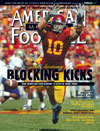AMERICAN FOOTBALL MONTHLY THE #1 RESOURCE FOR FOOTBALL COACHES
Article CategoriesAFM Magazine
|
The Drills Report: Minnesota Wide Receivers Drills© More from this issueAt Minnesota we believe there are keys to playing the wide receiver position in our offense. The topics that I would like to cover all build on one another with one being no greater than the other. The topics I would like to discuss with you are: 1 Route Expression. 2. Release Techniques. 3. Ball Catching. Route Expression Our offense relies heavily on our receivers getting good vertical stretch, running precise routes, and being able to create separation from defenders by transitioning in and out of breaks quickly. We emphasize to our receivers that we want to drive in and run out of cuts. What this means is that we want to get to top speed as soon as possible once the ball is snapped. As we reach our break point, we want to ‘snap’ our chest down over our toes w....The full article can only be seen by subscribers. Subscribe today!
|
|
|||||||
| HOME |
MAGAZINE |
SUBSCRIBE | ONLINE COLUMNISTS | COACHING VIDEOS |
Copyright 2026, AmericanFootballMonthly.com
All Rights Reserved





